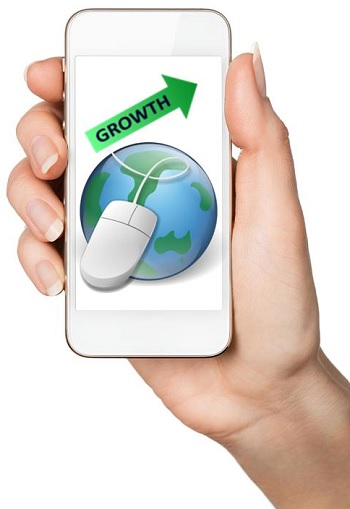Report highlights the recent successes of the mobile shopping space and e-commerce
Internet Retailer has released a new report concerning mobile and e-commerce throughout the world. The global e-commerce market is growing at a rapid pace as smartphone adoption accelerates. More people are using their mobile devices in their daily lives and this is putting more focus on mobile shopping. Using a smartphone to shop online or at a physical store is becoming easier and new mobile commerce services are proving to be rewarding for consumers that use them.
21% of all e-commerce sales come from mobile devices
The report from Internet Retailer shows that mobile now accounts for 21% of all e-commerce sales. The report expects that mobile commerce will generate some $84 billion globally by the end of this year. Conventional online shopping from a desktop computer still accounts for the majority of e-commerce activity, but this is beginning to change as more consumers show favor for shopping from their mobile devices.
Mobile websites are favored over applications by mobile shoppers
 The report anticipates that 42% of mobile sales will come from applications while 58% will come from mobile websites. Apps are often seen as useful mobile commerce tools, but websites designed to cater to a mobile audience have a greater impact in the e-commerce space. The quality of these sites can determine whether or not a purchase is finalized and can influence a consumer’s interest in mobile shopping. A poorly designed website could drive people away from mobile commerce relatively easily.
The report anticipates that 42% of mobile sales will come from applications while 58% will come from mobile websites. Apps are often seen as useful mobile commerce tools, but websites designed to cater to a mobile audience have a greater impact in the e-commerce space. The quality of these sites can determine whether or not a purchase is finalized and can influence a consumer’s interest in mobile shopping. A poorly designed website could drive people away from mobile commerce relatively easily.
Security is becoming less of a problematic issue for the mobile world
Mobile commerce has been finding more success recently as certain security concerns have been laid to rest. When it comes to shopping online, consumers often worry about the security of their financial information. Many mobile commerce platforms of the past few years have lacked sufficient security measures that could protect this information and retailers found it difficult to keep this information secure as well. As the sector continues to mature, retailers are finding better security solutions, ensuring that consumer information is kept safe.
Wearable devices will be used in new study from the Michael J. Fox Foundation and Intel
Wearable technology may hold some promise when it comes to researching Parkinson’s Disease. The Michael J. Fox Foundation and Intel have teamed together to study how wearable devices could be used to detect data on the various symptoms of the disease. The information will be uploaded into a cloud computer network and this information will be available to researchers for free. Some 60,000 people in the U.S. alone are diagnosed with Parkinson’s Disease every year and understanding this affliction is beginning to become more important.
Mobile technology is beginning to see more practical uses
Mobile technology plays a significant role in society today, but typically only fills entertainment and social needs. Smartphones allow people to stay in constant contact with one another through the Internet and through a mobile network. Beyond that, mobile technology has only very recently begun to see more attention as a way to gather information about certain medical problems and similar issues.
Study aims to help patients keep track of their symptoms more effectively
 Through the study, data concerning the slowness of movement, tremors, and sleep quality of those suffering from Parkinson’s Disease will be collected. Wearable devices may also help patients self-report their symptoms and how these symptoms affect their lives more efficiently. A small-scale study was held earlier this year in which patients used wearable devices to offer up information about their symptoms. Those participating in the study noted that wearable devices kept track of their symptoms more effectively.
Through the study, data concerning the slowness of movement, tremors, and sleep quality of those suffering from Parkinson’s Disease will be collected. Wearable devices may also help patients self-report their symptoms and how these symptoms affect their lives more efficiently. A small-scale study was held earlier this year in which patients used wearable devices to offer up information about their symptoms. Those participating in the study noted that wearable devices kept track of their symptoms more effectively.
Wearable technology has seen little practical use in the past few years, but that may be changing quickly
Wearable technology is gaining popularity, but wearable devices are typically seen as novelty rather than practical tools. Most wearable devices have to do with entertainment in some way, while others exist for social media purposes. There are very few of these devices currently available that represent some practical use. Some smartwatches, for instance, exist that help keep track of health information, but wearable devices have seen little practical use beyond this.
 The report anticipates that 42% of mobile sales will come from applications while 58% will come from mobile websites. Apps are often seen as useful mobile commerce tools, but websites designed to cater to a mobile audience have a greater impact in the e-commerce space. The quality of these sites can determine whether or not a purchase is finalized and can influence a consumer’s interest in mobile shopping. A poorly designed website could drive people away from mobile commerce relatively easily.
The report anticipates that 42% of mobile sales will come from applications while 58% will come from mobile websites. Apps are often seen as useful mobile commerce tools, but websites designed to cater to a mobile audience have a greater impact in the e-commerce space. The quality of these sites can determine whether or not a purchase is finalized and can influence a consumer’s interest in mobile shopping. A poorly designed website could drive people away from mobile commerce relatively easily.
 Through the study, data concerning the slowness of movement, tremors, and sleep quality of those suffering from Parkinson’s Disease will be collected. Wearable devices may also help patients self-report their symptoms and how these symptoms affect their lives more efficiently. A small-scale study was held earlier this year in which patients used
Through the study, data concerning the slowness of movement, tremors, and sleep quality of those suffering from Parkinson’s Disease will be collected. Wearable devices may also help patients self-report their symptoms and how these symptoms affect their lives more efficiently. A small-scale study was held earlier this year in which patients used 